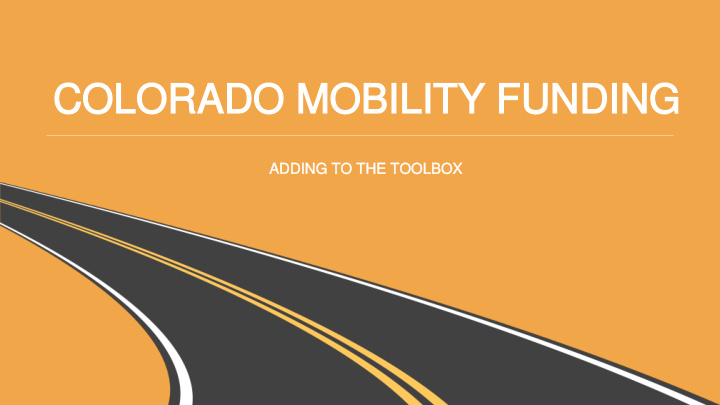



COLORADO MOBILITY FUNDING COLORADO MOBILITY FUNDING ADDING TO THE TOOLBOX ADDING TO THE TOOLBOX
FEBRUARY 20 BOARD DISCUSSION FEBRUARY 20 BOARD DISCUSSION Metro Mayors Caucus discussions, 2012 -present Failure of Proposition 110 Local and regional discussions reemerge Options for regional funding Continue discussions, engage with counties, evaluate enabling legislation options for E -MPO
2019 2019 —THE CURRENT THE CURRENT LOCAL SITUATION LOCAL SITUATION • local needs and shortfalls continue to grow • individual city and county funding talks threaten fracture
“ALL ROADS ARE “ALL ROADS ARE LOCAL LOCAL ” ” (almost) (almost) • 75% of paved lane miles are maintained by local jurisdictions • 33,000 by cities • 32,000 by counties • 23,000 by CDOT
REGIONAL MOBILITY TOOLS REGIONAL MOBILITY TOOLS —GOALS GOALS • accelerate regional and local priorities • address congestion, pavement conditions and mobility needs • allow each region to determine • priorities • equity • rate • distribution • hold harmless –similar to regional transportation authorities and High-Performance Transportation Enterprise
REGIONAL TRANSPORTATION AUTHORITIES (RTA) REGIONAL TRANSPORTATION AUTHORITIES (RTA) new regional transportation authority formed under existing statute or after amendments PROS PROS CONS CONS • on statute and well-tested • designed for small collaborations • seven RT • As across state holdouts make corridor investments difficult • Pikes Peak RT A similar but smaller • creates new governing body with one representative per participant
METRO TRANSPORTATION COLLABORATIVES (MTC) METRO TRANSPORTATION COLLABORATIVES (MTC) authorize new metro transportation collaboratives via legislation to set boundaries and governance PROS PROS CONS CONS • • refine governance in legislation requires legislation for to meet regional needs each MT C • • no need for multiple new layer of government for intergovernmental agreements each created • contiguity and continuity
EMPOWER METROPOLITAN PLANNING ORGs (E EMPOWER METROPOLITAN PLANNING ORGs (E -MPO) MPO) empower five existing metropolitan planning organizations with RT A-like taxing authority (same option for transportation planning regions?) PROS PROS CONS CONS • no new government • requires new legislation • no formation costs • not a quick fix • experienced staff • MPOs cover 83% of state population • regions can tailor funding and priorities to local needs
COLORADO’S COLORADO’S FIVE FIVEMPOS MPOS PERCENT OF MPO POPULATION STATE POPULATION DRCOG 3,168,900 57.00% PPACOG 681,469 12.30% PACOG 151,301 2.70% GVMPO 130,419 2.40% NFRMPO 494,257 8.90% Total 4,626,346 83.00%
• de-Brucing–2019 ballot FILLING THE FILLING THE TOOLBOX TOOLBOX ? • TRANS in 2020 • General Fund transfers • public-private partnerships ? • road-use charge • RTAs • E-MPOS • local sales taxes
NEXT STEPS NEXT STEPS Identify statute for Reach out to MPOs and Explore public awareness E-MPO authority jurisdictions statewide campaign
Recommend
More recommend